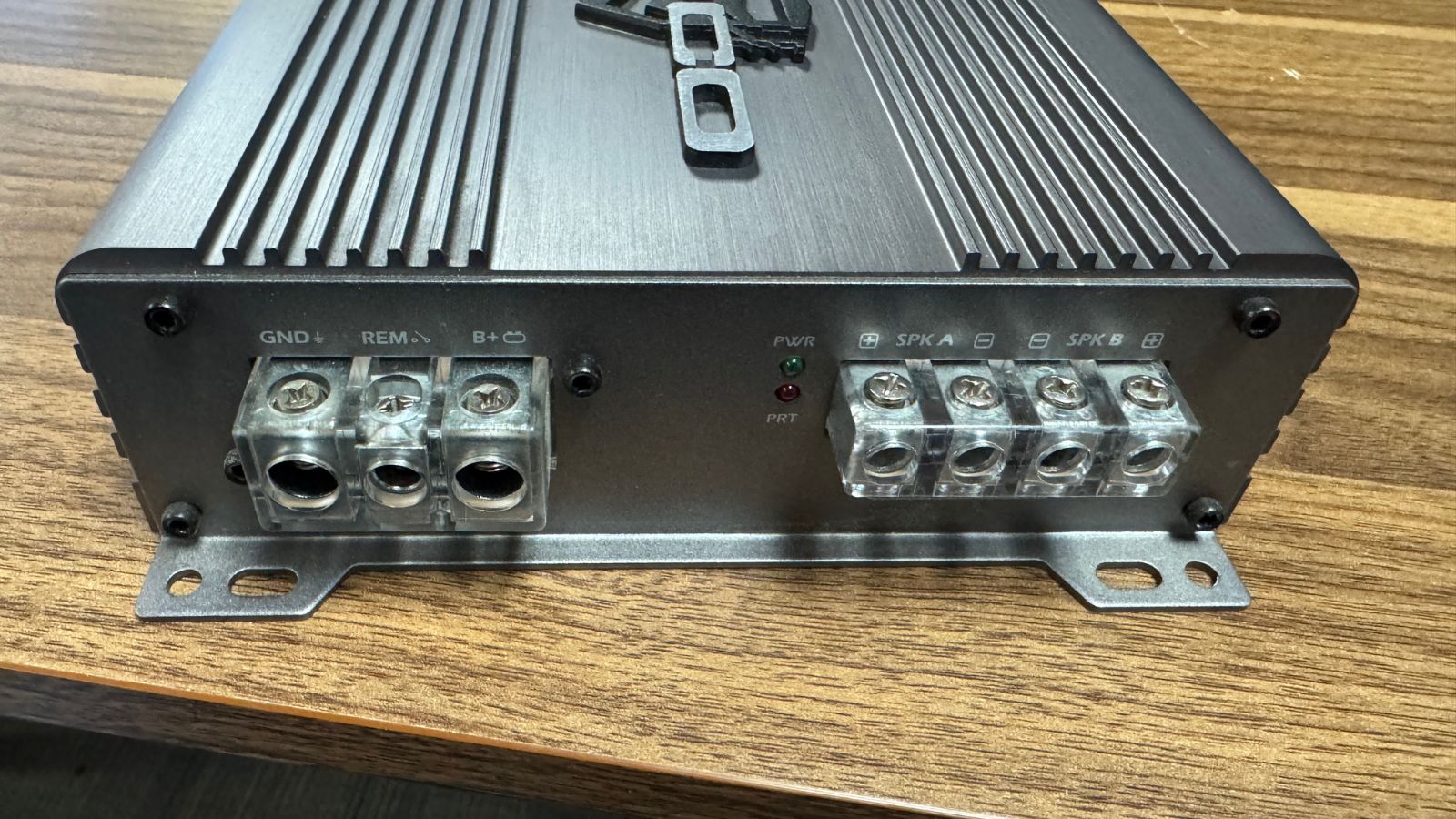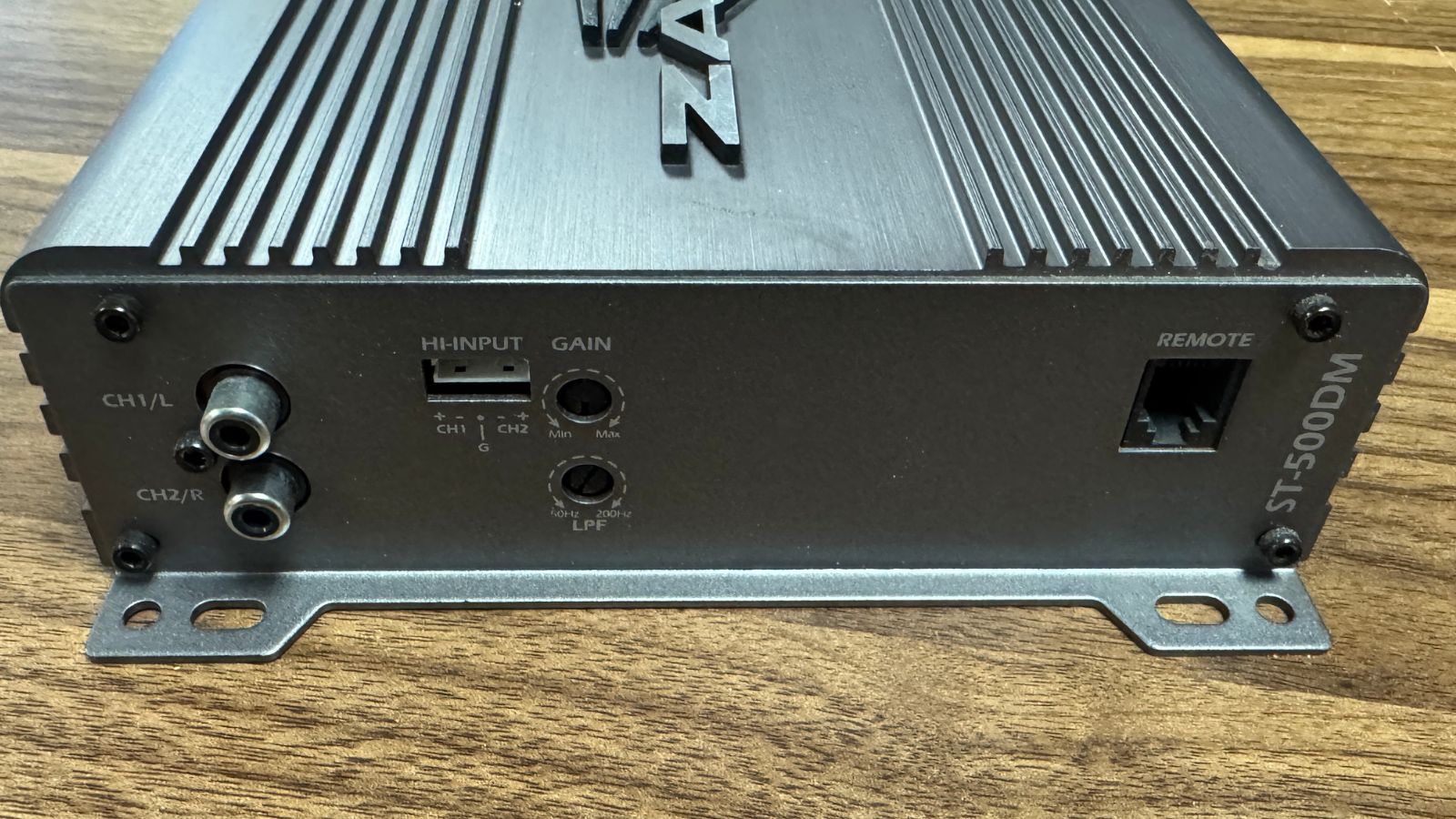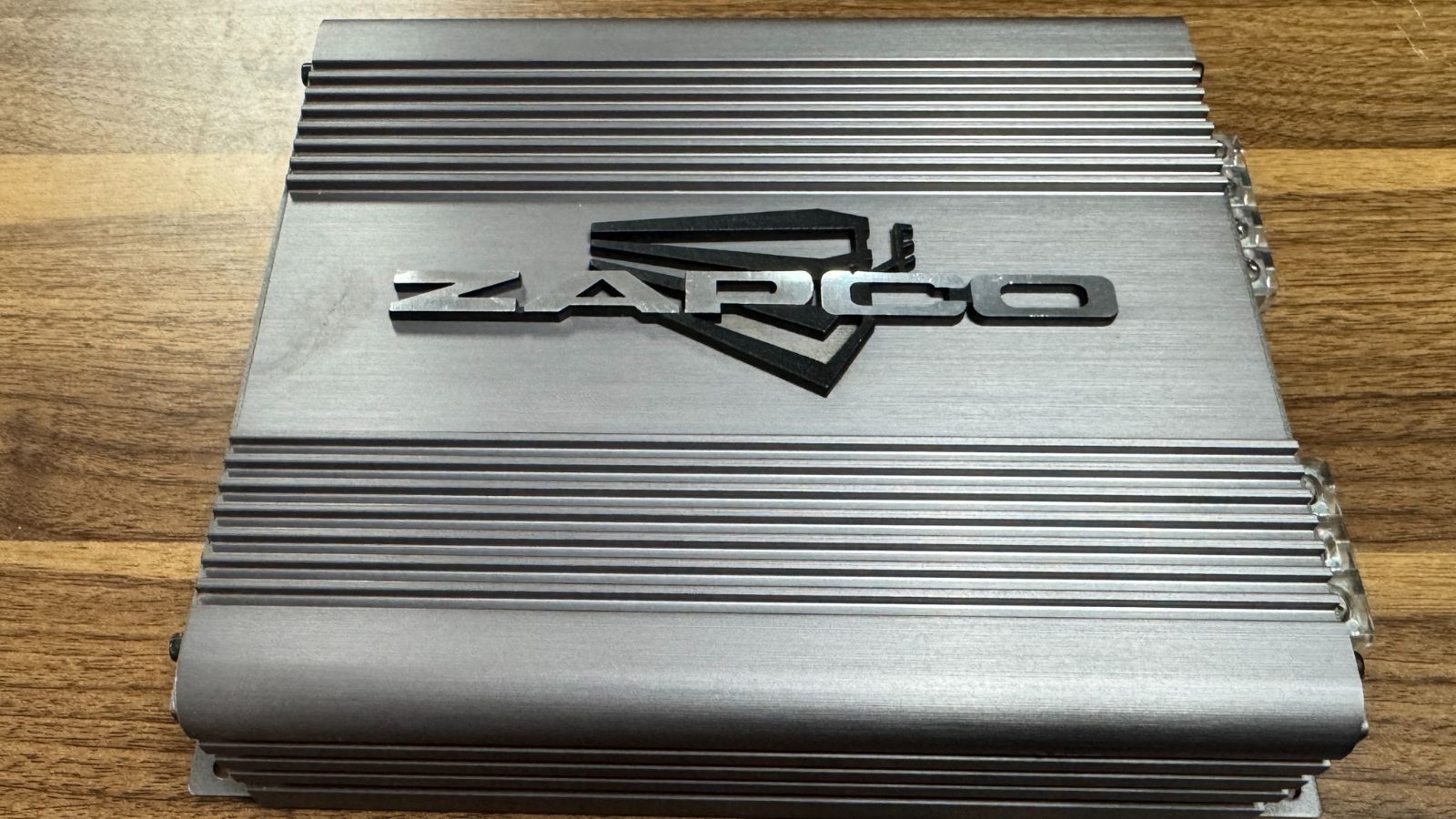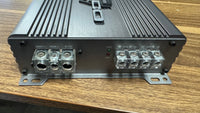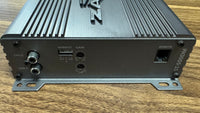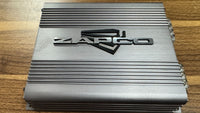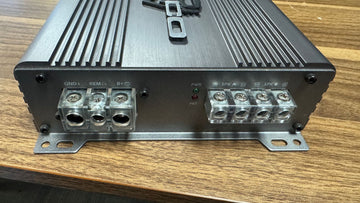Zapco ST-500DM Monoblock Amplifier | Previous Demo

Professionally Maintained Demo Units
Every demo unit has been carefully maintained by our certified technicians. These aren't customer returns or damaged goods - they're the same high-quality equipment we've used to demonstrate premium sound to our customers for years.

Pre-Tested & Verified
Unlike typical clearance sales, every item has been tested and verified by our technical team. We stand behind the quality of our relocation inventory.

Everything Must Go Pricing
These aren't regular sale prices - this is genuine "moving warehouse" pricing. Discounts you simply won't find under normal retail circumstances.

Trade Show Display Models
Many items are pristine display models from major audio trade shows - equipment that's been seen but never installed. These pieces often include special editions or limited releases not available through regular retail channels.
Zapco ST-500DM Monoblock Amplifier
50 Years of High Fidelity Engineering Excellence
🔍 Item Condition & Transparency
Condition: This Zapco ST-500DM monoblock amplifier is in great condition, showing normal signs of previous ownership and installation. The amplifier has been thoroughly tested and verified to meet factory performance specifications across all power output levels.
What's Missing: Please note the following items are not included with this amplifier:
- Original Retail Packaging: The amplifier does not include its factory box or packaging materials. It will be carefully packed in protective materials for safe shipping. This is purely a cosmetic consideration for collectors and does not affect performance in any way.
- Sub Level Control (Bass Remote): The factory bass knob remote control is not included. However, subwoofer output level is fully controllable via the amplifier's onboard gain control and bass boost adjustment. For ultimate convenience, an aftermarket universal bass knob can be added for approximately $15-25 if preferred for dash-mounted bass adjustment.
What's Included: The amplifier itself with all critical mounting hardware and connection terminals in excellent working order. Power connections, RCA inputs/outputs, and speaker terminals are all gold-plated and fully functional.
Performance Verification: This unit has been bench-tested to confirm proper power output at 4Ω, 2Ω, and 1Ω loads. All protection circuits (thermal, over-current, speaker short, DC offset) are functioning correctly. Crossover, subsonic filter, and gain controls all operate smoothly through their full adjustment ranges.
This amplifier represents exceptional value for anyone seeking Zapco's legendary sound quality and reliability at a reduced price point due to the missing accessories. Core performance and sonic excellence remain completely unaffected.
The Zapco Legacy: 50 Years of Innovation
In 1974, when most "car stereo" meant tinny AM radios and mediocre factory speakers, a visionary audio engineer working concert sound systems recognized the need for true high-fidelity amplification in automotive environments. Traveling between concert venues across the country, he was frustrated by the noise-plagued car audio systems of the era. His solution? Design the first genuine high-fidelity car amplifier from the ground up.
Working in his family's barn in California farm country, he took a straightforward amplifier design and solved the endemic noise problem through radical innovation: separating the power supply from the amplifier circuit entirely. By mounting the power supply in its own chassis, he provided the amplifier section with clean, noise-free high voltage AC current. The result was an odd-looking three-piece amplifier that sounded absolutely extraordinary. Word spread quickly among audio enthusiasts, and requests for custom builds multiplied.
In 1974, Zapco was officially incorporated, and the Model 150 was introduced to the world. It wasn't just another car amplifier—it was the first true high-fidelity car amplifier, setting standards that define the industry fifty years later.
Industry-First Innovations
Throughout the 1980s and beyond, Zapco pioneered technologies that are now standard in premium car audio amplifiers:
Optical Isolators (1980s)
Zapco became the first car audio company to use optical isolators between power supply and amplifier sections, eliminating noise while allowing single-chassis designs. This innovation resulted in the legendary Z-220 amplifier and enabled the "live sound" character Zapco became famous for.
Complimentary Wound Transformers
Zapco pioneered complimentary winding techniques in transformer construction, reducing magnetic field interference and improving power supply efficiency—technologies now found in virtually all high-end car amplifiers.
Reversed Phase Inputs
Zapco introduced reversed phase inputs that allowed stereo amplifiers to be bridged into mono operation, doubling power output for subwoofer applications—a feature considered essential in modern amplifier design.
Tri-Wound Transformers
Developed tri-wound transformer technology allowing amplifiers to handle far more current than traditional designs, enabling higher sustained power output without thermal limiting.
Competition Dominance
By 2004, Zapco's amplifiers had become the dominant force in car audio sound quality competitions. At the IASCA World Finals that year, Zapco-equipped vehicles captured over 35% of all awards—an unprecedented achievement that demonstrated the brand's commitment to sonic purity and competitive performance.
In 2004, Zapco took another bold step by developing the DSP-6, the first full-function car audio DSP, followed by a complete line of amplifiers with integrated DSP processing. This foresight positioned Zapco at the forefront of the digital signal processing revolution that would transform car audio installation over the next decade.
The Z-Series Evolution
Since 2011, Zapco has continuously refined its amplifier designs through the Z-Series lineup:
- 2012 Z-Series Competition SQ Amplifiers: Received universal acclaim as the best-sounding Zapco amplifiers ever produced, earning comparisons to legendary McIntosh and Bryston home amplifiers
- 2014 Z-Series LX Amplifiers: Pure SQ amplifiers with no processing, featuring improved power supplies, audiophile-grade internal components, and superior hardware—ranked at the very top of blind listening tests above esoteric US and European brands
- 2016 Z-Series SP Amplifiers: Brought LX sound quality to full-featured amplifiers capable of continuous high-output operation without thermal concerns, featuring innovative heat transfer engineering and >105dB signal-to-noise ratios
- 2018 Z-Series AP Amplifiers: New op-amps, custom capacitors, matched components—designed to surpass most audiophile home products, period
The Philosophy: Sound Matters
For fifty years, Zapco has pursued a singular mission: innovative engineering that brings better sound to the automotive environment. Why? Because music has the power to grab your soul, bring tears to your eyes, make you tap your feet, and dance for joy. Of all the arts, music has the most powerful and immediate effect on body and mind.
"Reproducing music in all its glory, subtleness, and detail deserves nothing less than our best efforts. Because Sound Matters."
Technical Specifications
| Specification | Value |
|---|---|
| Model | ST-500DM |
| Series | ST-Series D (Studio D-Series) |
| Amplifier Class | Class D (Pulse Width Modulation) |
| Configuration | Monoblock (Single Channel) |
| RMS Power @ 4Ω | 160W RMS |
| RMS Power @ 2Ω | 310W RMS |
| RMS Power @ 1Ω | 500W RMS |
| Peak Power @ 1Ω | 1000W Max |
| Impedance Stability | 4Ω to 1Ω (stable operation) |
| THD + Noise | <0.02% @ 4Ω (rated power) |
| Signal-to-Noise Ratio | 90 dB |
| Test Voltage | 14.4V DC |
| Power Supply Type | PWM (Pulse Width Modulation) MOSFET |
| Low-Pass Crossover | 80 Hz, 18 dB/octave slope (electronic) |
| Subsonic Filter | 30 Hz (protects against infrasonic content) |
| Input Type | RCA (signal input and output connectors) |
| RCA Pass-Through | Yes (daisy-chain multiple amplifiers) |
| Input Connectors | Gold-plated RCA terminals |
| Speaker Terminals | Gold-plated set-screw posts |
| Protection Circuitry | 4-Way: Thermal / Over-Current / Speaker Short / DC Offset |
| Dimensions (W × H × D) | 6.7" × 2.2" × 7.5" |
| Mounting Footprint | Compact (fits under seats, behind panels) |
Class D Amplification: Efficiency Meets Performance
The Zapco ST-500DM employs Class D amplification technology, representing the cutting edge of modern amplifier design. While Class D amplifiers were once criticized for inferior sound quality compared to traditional Class AB designs, modern implementations—particularly in premium brands like Zapco—have closed the performance gap while maintaining the significant advantages of Class D topology.
PWM MOSFET Power Supply
At the heart of the ST-500DM is a Pulse Width Modulation (PWM) MOSFET power supply. This sophisticated switching power supply converts the vehicle's 12-14.4V DC electrical system into the high-voltage rails required for amplification. The PWM design operates at high frequencies (typically 50-100 kHz), allowing smaller transformers and filter components while maintaining excellent regulation under varying load conditions.
The MOSFET (Metal-Oxide-Semiconductor Field-Effect Transistor) devices used in the power supply and output stage offer several advantages over traditional bipolar transistors:
- Faster Switching Speed: MOSFETs can switch on and off in nanoseconds, reducing switching losses and improving efficiency
- Lower On-Resistance: When fully conducting, MOSFETs present very low resistance, minimizing power dissipation and heat generation
- Voltage-Controlled Operation: MOSFETs require minimal gate current, simplifying driver circuitry and improving reliability
- Thermal Stability: Positive temperature coefficient prevents thermal runaway issues common in bipolar designs
Class D Efficiency Advantages
Traditional Class AB amplifiers operate with efficiency around 50-60%, meaning nearly half the power drawn from the electrical system is converted to heat rather than audio output. The ST-500DM's Class D design achieves efficiency ratings of 80-85% or higher, providing several critical benefits:
Reduced Thermal Load
At 500W output, a Class AB amplifier might dissipate 400-500W as heat. The ST-500DM dissipates only 100-125W, dramatically reducing cooling requirements and allowing the compact 6.7" × 7.5" footprint.
Lower Electrical System Demand
Drawing 500W of audio output from a Class AB amplifier requires ~1000W from the electrical system. The ST-500DM requires only ~625W, reducing strain on alternator, battery, and wiring infrastructure.
Sustained Power Delivery
Reduced heat generation means the amplifier can sustain full rated power for extended periods without thermal limiting—critical for bass-heavy music with continuous high-power demands.
Flexible Installation
Compact dimensions and reduced cooling needs allow installation in tight spaces: under seats, behind panels, in trunk corners—locations impossible for larger, hotter-running Class AB designs.
Sonic Performance: Modern Class D Excellence
The ST-500DM achieves Total Harmonic Distortion (THD) below 0.02% at rated power—performance that rivals or exceeds many Class AB amplifiers. This exceptional linearity results from several design factors:
- High Switching Frequency: Modern Class D amplifiers operate at switching frequencies well above the audio band (typically 300-600 kHz), pushing switching artifacts far beyond audibility and simplifying output filter design
- Advanced Feedback Topologies: Sophisticated error correction circuits continuously compare output to input, correcting distortion in real-time
- Quality Output Filtering: Properly designed low-pass filters remove switching frequency components while preserving audio signal integrity through the full 20 Hz - 20 kHz bandwidth
The 90 dB signal-to-noise ratio ensures a silent noise floor, allowing subtle bass details to emerge from complete silence rather than a background of hiss or hum. Combined with less than 0.02% THD, the ST-500DM delivers clean, accurate bass reproduction with the transient response and dynamic impact that modern music demands.
Monoblock Advantages for Subwoofer Applications
The ST-500DM's monoblock (single-channel) configuration is purpose-built for subwoofer duty, offering significant advantages over multi-channel amplifiers in bass applications:
Dedicated Power Supply
In multi-channel amplifiers, the power supply must distribute available current across all channels. When multiple channels demand high current simultaneously, voltage rails can sag, limiting dynamic headroom. The ST-500DM's monoblock design dedicates the entire power supply capacity to a single channel, ensuring maximum current availability for demanding bass transients.
This dedicated architecture becomes critical during bass-heavy musical passages where sustained power demands can exceed 500W for multiple seconds. The ST-500DM's power supply and output stage are sized specifically for continuous 500W @ 1Ω operation without thermal limiting or voltage rail collapse.
1Ω Stability: Maximum Power Transfer
The ST-500DM is stable down to 1Ω impedance, allowing several powerful wiring configurations:
- Single 1Ω Subwoofer: Rare, but if you have a 1Ω DVC (Dual Voice Coil) wired in parallel, you achieve full 500W output
- Dual 2Ω SVC (Single Voice Coil) Subwoofers: Wired in parallel = 1Ω final impedance = 500W RMS distributed across both drivers
- Single 2Ω DVC Subwoofer: Both voice coils wired in parallel = 1Ω = 500W RMS to a single high-power subwoofer
- Single 4Ω Subwoofer: 160W RMS—ideal for efficient subwoofers in sealed enclosures where moderate power produces substantial output
- Dual 4Ω SVC Subwoofers: Wired in parallel = 2Ω = 310W RMS distributed across both drivers
This 1Ω stability provides maximum flexibility in system design, allowing you to extract the full potential from virtually any subwoofer configuration without being limited by amplifier impedance constraints.
Simplified Gain Structure
With monoblock amplifiers, gain adjustment is straightforward: set the input sensitivity to match your source unit's output voltage, and you're done. There's no need to balance gain across multiple channels or worry about channel-to-channel variation. The single gain control adjusts input sensitivity from ~200mV to ~5V, accommodating everything from factory head units to high-voltage aftermarket processors.
Compact Single-Purpose Design
Because the ST-500DM is optimized for a single task—subwoofer amplification—Zapco engineers could maximize performance within the compact 6.7" × 7.5" footprint. There are no compromises for multi-channel flexibility, no wasted board space for unused channels, no thermal management challenges from powering multiple channels simultaneously. Every component serves a single purpose: deliver clean, powerful bass.
Integrated Crossover & Subsonic Protection
80 Hz Low-Pass Crossover (18 dB/Octave)
The ST-500DM includes an integrated 80 Hz low-pass crossover with 18 dB/octave slope, providing proper frequency band-limiting for subwoofer operation. This electronic crossover prevents high-frequency content from reaching your subwoofers, protecting them from attempting to reproduce midrange and treble frequencies they're not designed to handle.
Why 80 Hz? This frequency represents a carefully chosen crossover point for most subwoofer applications:
- Localization Prevention: Below 80 Hz, human hearing loses the ability to localize sound sources accurately. This means bass appears to come "from everywhere" rather than from a specific location—critical for proper subwoofer integration regardless of physical placement
- Overlap with Speakers: Most full-range and component speakers maintain usable response down to 70-90 Hz, creating natural overlap with the subwoofer crossover and ensuring seamless transition without gaps or peaks
- Enclosure Optimization: Subwoofer enclosures are optimized for frequencies below 80-100 Hz. Asking them to reproduce higher frequencies results in peaks, resonances, and coloration
- Power Efficiency: By restricting the subwoofer to true bass frequencies, amplifier power is concentrated where it's needed most rather than wasted on midrange content
18 dB/Octave Slope: This relatively steep crossover slope provides -18 dB of attenuation for every doubling of frequency above 80 Hz. At 160 Hz (one octave above crossover), the amplifier is already down 18 dB; at 320 Hz (two octaves up), it's down 36 dB. This aggressive filtering protects subwoofers from midrange content while maintaining clean, controlled transition at the crossover point.
30 Hz Subsonic Filter: Infrasonic Protection
Below approximately 25-30 Hz, music contains little usable content. However, this infrasonic region can harbor several dangers:
- Ported Enclosure Unloading: Below tuning frequency, ported enclosures lose acoustic loading, allowing woofers to over-excursion and potentially sustain mechanical damage
- Wasted Power: Amplifier power spent reproducing inaudible infrasonic content is power unavailable for actual music
- Cone Cry and Distortion: Excessive excursion in the infrasonic region generates audible distortion products that color higher frequencies
- Microphone Wind Noise: Live recordings often contain microphone wind rumble in the 10-25 Hz region—completely inaudible but capable of driving subwoofers to dangerous excursion levels
The ST-500DM's 30 Hz subsonic filter provides a high-pass characteristic that progressively attenuates content below 30 Hz, protecting your subwoofers from infrasonic threats while preserving the deep bass extension that makes music impactful. For ported enclosures tuned to 32-35 Hz (common in modern designs), this 30 Hz filter provides ideal protection without sacrificing usable output.
Integration with External Processing
If you're using an external DSP or active crossover (like the Goldhorn DSPA 810 Pro), you have several options:
Option 1: Use the ST-500DM's built-in crossover and subsonic filter for redundancy and additional protection—even if your DSP already provides filtering, the amplifier's integrated protection offers a safety net.
Option 2: Rely on your DSP's more flexible crossover controls (adjustable frequency, slope, Q-factor) and use the ST-500DM's crossover as backup protection only.
In most installations, Option 1 is recommended: the amplifier's integrated filters add no signal degradation and provide valuable protection if DSP settings are accidentally changed or if the system is temporarily used without the DSP active.
Comprehensive 4-Way Protection System
The ST-500DM incorporates four independent protection circuits that monitor amplifier operation continuously, protecting both the amplifier and your speakers from damage under fault conditions:
1. Thermal Protection
Temperature sensors mounted on the MOSFET heatsinks monitor junction temperature continuously. If internal temperature exceeds safe thresholds (typically 85-95°C at the heatsink), the amplifier progressively reduces output power to allow cooling. If temperature continues rising despite power reduction, the amplifier enters protection mode (shutdown) until temperature returns to safe levels.
This intelligent thermal management allows the ST-500DM to sustain high power output indefinitely under normal conditions while preventing damage during extreme circumstances (inadequate ventilation, extremely high ambient temperatures, sustained full-power operation).
2. Over-Current Protection
Current-sensing circuitry monitors output current continuously, detecting conditions where current demand exceeds safe levels. This can occur during:
- Extremely low impedances (attempting to drive loads below 1Ω)
- Speaker terminal short circuits
- Internal component failures
When over-current is detected, the amplifier immediately enters protection mode, disconnecting the output stage and preventing damage to MOSFETs and power supply components. This protection is non-latching—once the fault condition is cleared, normal operation resumes automatically.
3. Speaker Short Protection
If the positive and negative speaker terminals are accidentally shorted together (directly or through damaged speaker wire insulation), the resulting near-zero impedance would normally draw catastrophic current levels. The ST-500DM's speaker short protection detects this condition within microseconds and shuts down the output stage before damage can occur.
This protection is particularly valuable during installation when bare wire ends might accidentally touch metal surfaces, or in mobile environments where vibration can damage wire insulation over time.
4. DC Offset Protection
Audio signals are AC (alternating current)—they oscillate symmetrically above and below zero voltage. However, certain fault conditions can cause the output to develop a DC (direct current) offset—a constant positive or negative voltage that doesn't oscillate. This DC voltage can:
- Overheat voice coils (DC causes continuous power dissipation rather than intermittent audio signal heating)
- Drive subwoofer cones into mechanical limits (DC pushes the cone to one extreme of travel)
- Damage speaker suspension through constant mechanical stress
The ST-500DM monitors output DC voltage continuously. If DC offset exceeds safe thresholds (typically 1-2V DC), the amplifier enters protection mode, disconnecting the speakers from the potentially damaging DC voltage.
Protection LED Indicator
The ST-500DM features a protection LED that illuminates when any protection circuit is active. During normal operation, the LED remains off. If the LED illuminates:
- Check speaker impedance: Ensure you're not driving the amplifier below 1Ω
- Inspect wiring: Look for shorts between speaker terminals or damaged insulation
- Verify ventilation: Ensure adequate airflow around the amplifier for cooling
- Check gains: Excessive gain settings can cause clipping-related overheating
Once the fault condition is corrected, the amplifier will automatically resume normal operation. Persistent protection mode indicates a problem requiring attention before continued use.
Bass Level Control Options
This particular ST-500DM unit does not include the factory sub level control (bass remote knob). However, you have several excellent options for bass level adjustment:
Option 1: Onboard Gain Control
The most straightforward approach is using the amplifier's built-in gain control directly. Located on the amplifier's end panel, the gain adjustment allows you to set overall subwoofer output level. While this requires physical access to the amplifier rather than convenient dash-mounted control, it's perfectly functional for installations where bass level rarely needs adjustment.
Setting Procedure:
- Play familiar music with substantial bass content at your typical listening volume
- Adjust the gain control until bass output matches your preference and integrates properly with front speakers
- Once set, most users find they rarely need to readjust—the amplifier maintains consistent output levels
Option 2: Aftermarket Universal Bass Knob
If you prefer dash-mounted bass control, universal aftermarket bass knobs are widely available for $15-25 from retailers like Crutchfield, Sonic Electronix, and Amazon. These devices connect between your source unit and amplifier, providing a dash-mounted rotary control for real-time bass adjustment.
Popular Options:
- PAC SNI-1/3.5: Variable bass control with mounting hardware (~$20)
- Kicker KISLOC: Remote level control with industrial-grade construction (~$25)
- AudioControl ACR-1: Premium remote with dual controls for front/rear or sub channels (~$40)
Installation is straightforward: the bass knob's RCA cables connect inline between your source unit's subwoofer output and the ST-500DM's RCA input. The control knob mounts in your dash or console via included adhesive pad or screw mount. Total installation time is typically 15-20 minutes.
Option 3: DSP-Based Control
If you're using an external DSP like the Goldhorn DSPA 810 Pro or similar processor, bass level adjustment is handled through the DSP's software interface. Most modern DSPs offer:
- Subwoofer Output Level Control: Adjust subwoofer gain independently from other channels
- Multi-Memory Presets: Store different bass level settings for different music genres or listening preferences, switchable via remote or smartphone app
- Real-Time Adjustment: Modify settings via Bluetooth smartphone app without physical access to equipment
In DSP-equipped systems, the amplifier's gain is typically set once during initial calibration, with all subsequent adjustments handled through DSP output level controls.
Option 4: Source Unit Bass/EQ Controls
Modern aftermarket head units and factory systems with upgraded interfaces often include bass boost or subwoofer level controls in their menu systems. These digital controls adjust the subwoofer pre-amp output voltage before it reaches the amplifier, providing convenient dash-mounted control without additional hardware.
Check your source unit's audio settings menu for options like "Subwoofer Level," "Bass Boost," or "Low Frequency Gain." These functions provide the same real-time control as a dedicated bass knob while utilizing your existing head unit interface.
Installation Guidelines & Best Practices
Mounting Location Selection
The ST-500DM's compact dimensions (6.7" × 2.2" × 7.5") and efficient Class D design provide exceptional installation flexibility:
Under Seat
The most popular location for compact monoblock amplifiers. Provides easy access for adjustment while remaining invisible. Ensure at least 2-3 inches of clearance above the amplifier for ventilation.
Trunk/Cargo Area
Traditional amplifier mounting location offers maximum space and ventilation. Mount to a solid surface using the amplifier's mounting feet. Keep away from subwoofer enclosures to prevent acoustic vibration.
Behind Trim Panels
For stealth installations, the ST-500DM can be mounted behind kick panels, quarter panels, or rear deck trim. Ensure adequate ventilation—consider drilling vent holes or using perforated trim if necessary.
Amplifier Rack
In multi-amplifier installations, mount the ST-500DM alongside other amplifiers on a custom amplifier rack or board. Space amplifiers at least 1-2 inches apart for airflow between units.
Power Wire Sizing
At 500W RMS output with approximately 80% efficiency, the ST-500DM draws roughly 50-55 amps maximum current from the 12V electrical system (accounting for voltage drop under load). Proper wire gauge selection is critical for safety and performance:
| Wire Length (from battery) | Minimum Wire Gauge |
|---|---|
| 0-4 feet | 8 AWG |
| 4-7 feet | 8 AWG |
| 7-10 feet | 6 AWG |
| 10-13 feet | 6 AWG |
| 13-16 feet | 4 AWG |
| 16-20 feet | 4 AWG (recommended 2 AWG) |
Fusing Requirements: Install a fuse within 18 inches of the battery connection, rated at 60-80 amps. This protects the power wire from overheating in the event of a short circuit. Use AGU, ANL, or MIDI fuse types—never standard automotive blade fuses for high-current amplifier applications.
Ground Connection Critical Importance
The quality of the ground connection directly affects amplifier performance. Follow these guidelines for optimal grounding:
- Ground Wire Gauge: Use the same gauge for ground as you used for power—never smaller
- Connection Point: Ground directly to chassis metal within 36 inches of amplifier location if possible
- Surface Preparation: Sand or grind the grounding point to bare metal, removing all paint, rust, and coating
- Fastener Quality: Use stainless steel bolts with star washers and lock nuts—never self-tapping screws
- Multi-Amplifier Systems: Ground all amplifiers to the same point to prevent ground loop hum
RCA Signal Routing
The ST-500DM accepts standard RCA input from your source unit or DSP. Follow these routing best practices:
- Separation from Power: Run RCA cables on the opposite side of the vehicle from power wire to minimize electrical noise induction
- Avoid Interference Sources: Keep RCA cables away from ignition wires, fuel pumps, power antennas, and other noise-generating components
- Quality RCA Cables: Use twisted-pair shielded RCA cables with quality connectors—cheap cables invite noise problems
- Pass-Through Output: The ST-500DM includes RCA output for daisy-chaining signal to additional amplifiers without multiple splitters
Initial Setup Procedure
Follow this systematic procedure for optimal amplifier performance:
- Turn Off System: Ensure head unit is powered off and amplifier gain is at minimum
- Connect Speakers: Connect subwoofer(s) to amplifier terminals—verify correct polarity (+ to +, - to -)
- Set Crossover: The 80 Hz low-pass crossover should be enabled for subwoofer applications
- Power Up System: Turn on head unit at moderate volume
- Adjust Gain: Slowly increase gain until desired bass output is achieved—set conservatively to avoid clipping
- Verify Integration: Play music with natural bass content—ensure subwoofer integrates seamlessly with front speakers without gaps or overwhelming output
- Fine-Tune Phase: If your subwoofer enclosure has a phase switch or your DSP has phase/delay controls, experiment with settings to maximize output and smoothness
System Integration & Application Scenarios
Factory System Upgrade
The ST-500DM excels in factory system upgrades where you want to add serious subwoofer performance without replacing the entire audio system. Connect the amplifier to factory subwoofer outputs (if present) or use a line-output converter (LOC) to tap into factory speaker wires. The ST-500DM's wide input sensitivity range (200mV - 5V) accommodates low-voltage factory signals without issue.
Typical Configuration:
- Factory head unit → Line output converter → ST-500DM → Subwoofer(s)
- Maintain factory speakers and head unit functionality
- Add bass extension and impact impossible with factory subwoofer
- Optional: Add aftermarket bass knob for convenient level control
Aftermarket Component System
In full aftermarket installations with component speakers and DSP processing, the ST-500DM handles dedicated subwoofer duty while other amplifiers power front and rear speakers. This specialized approach allows each amplifier to excel at its specific task.
Typical Configuration:
- Aftermarket head unit → DSP (like Goldhorn DSPA 810 Pro) → Multiple amplifiers
- ST-500DM dedicated to subwoofer channel from DSP
- Separate amplifiers for front components, rear fill, center channel, etc.
- DSP handles all crossovers, time alignment, EQ—amplifier crossover as backup protection
Competition SQ (Sound Quality) System
While Zapco is renowned for its high-end Z-Series competition amplifiers, the ST-500DM provides exceptional performance-per-dollar for budget-conscious competitors or enthusiasts who want competition-level sound without flagship pricing. The 90 dB S/N ratio and <0.02% THD ensure clean, detailed bass reproduction that won't hold back a well-designed system.
Competition Advantages:
- Clean Power: Low distortion preserves subtle details judges listen for
- Flexible Installation: Compact size allows optimal placement for system layout
- Reliable Performance: Zapco's 50-year reputation means you can trust the amplifier under competition stress
- Value Proposition: Use savings from ST-Series pricing to invest in higher-quality source, processing, or speakers
Marine Audio Application
While not marine-rated itself, the ST-500DM's Class D efficiency and compact size make it suitable for marine installations when properly protected from environmental exposure. Mount the amplifier in a sealed, weatherproof enclosure or dry storage compartment, and ensure all connections are protected with marine-grade heat shrink and dielectric grease.
The reduced current draw compared to Class AB amplifiers is particularly valuable in marine applications where electrical system capacity is often limited and alternator/battery upgrades are expensive and complex.
Multi-Subwoofer Configurations
The ST-500DM's 1Ω stability enables powerful multi-subwoofer systems:
Example Configuration 1: Dual 10" System
Subwoofers: 2× 10" SVC (Single Voice Coil) 2Ω subwoofers
Wiring: Both subwoofers wired in parallel = 1Ω final impedance
Power: 500W RMS total (250W per subwoofer)
Application: Balanced bass output in sedan trunk or SUV cargo area, each subwoofer in separate sealed enclosure (0.6-0.8 ft³ each)
Example Configuration 2: Single 12" High-Power System
Subwoofer: 1× 12" DVC (Dual Voice Coil) 2Ω subwoofer rated 500W RMS
Wiring: Both voice coils wired in parallel = 1Ω final impedance
Power: 500W RMS to single subwoofer
Application: Maximum impact system for bass-heavy music (hip-hop, EDM), ported enclosure tuned to 32-34 Hz for deep extension
Example Configuration 3: Dual 12" Efficiency System
Subwoofers: 2× 12" SVC 4Ω subwoofers rated 200W RMS each
Wiring: Both subwoofers wired in parallel = 2Ω final impedance
Power: 310W RMS total (155W per subwoofer)
Application: High-efficiency subwoofers in sealed enclosures, emphasis on sound quality over maximum SPL, reduced electrical system demands
50 Years of Innovation, Legendary Performance
Since 1974, Zapco has defined what high-fidelity amplification means in the automotive environment. From the first genuine car audio amplifier built in a California barn to today's sophisticated Class D designs, Zapco's commitment to sonic purity has never wavered.
This ST-500DM represents that legacy in an accessible, efficient package. While it lacks the original box and bass remote, its core performance remains completely intact: clean 500W RMS power, comprehensive protection, and the engineering excellence that made Zapco the dominant force in sound quality competitions.
The compact dimensions, efficient Class D design, and 1Ω stability provide exceptional installation flexibility. The integrated crossover and subsonic filter offer plug-and-play subwoofer protection. The 90 dB S/N ratio and <0.02% THD ensure clean, detailed bass reproduction.
This is authentic Zapco performance at an exceptional value—missing accessories reflected in pricing, not in sound quality.
Experience the amplifier brand trusted by sound quality competitors for five decades. Feel the impact of properly engineered Class D power. Hear the difference that half a century of innovation makes.
Because Sound Matters.
Zapco ST-500DM Monoblock Amplifier | Previous Demo
Frequently Asked Questions
Are these items authentic, and why are the prices so low?
This sale includes demo units we've used for customer demonstrations since 2016, new-old-stock from discontinued product lines, display models from trade shows, and carefully curated inventory we've collected over nearly a decade. Most items include original packaging where available.
What types of items are included in the relocation sale?
Our relocation sale includes demo units we've used for customer demonstrations, new old stock from discontinued product lines, and display models from trade shows. All items are genuine products from top car audio brands - we're simply clearing inventory we can't take to our new location. Items range from amplifiers and speakers to processors and accessories accumulated over nearly 10 years at this location.
Do sale items come with manufacturer warranties?
Warranty coverage varies by item and condition. New old stock items typically include full manufacturer warranty if still valid. Demo and display items may have limited or no manufacturer warranty remaining. We clearly state warranty status in each product description. All sales are final on relocation sale items.
How does shipping work for relocation sale items?
We ship relocation sale items using the same careful packaging methods as our regular inventory. Shipping costs are calculated at checkout based on size and weight. For multiple item purchases, we'll combine shipping where possible to save you money. Large items like subwoofer boxes may require freight shipping with additional costs.
Can I return or exchange relocation sale items?
All relocation sale items are sold as-is with no returns or exchanges. We encourage local pickup customers to inspect items before purchasing. For shipped items, we provide detailed descriptions and photos. Since we're relocating, we cannot accommodate returns or warranty service after the sale period ends.

